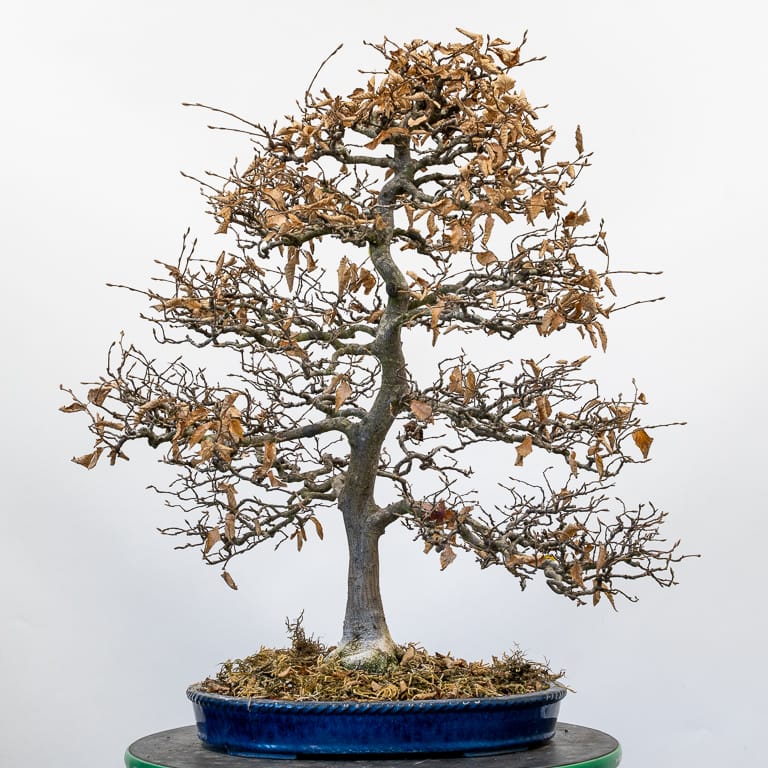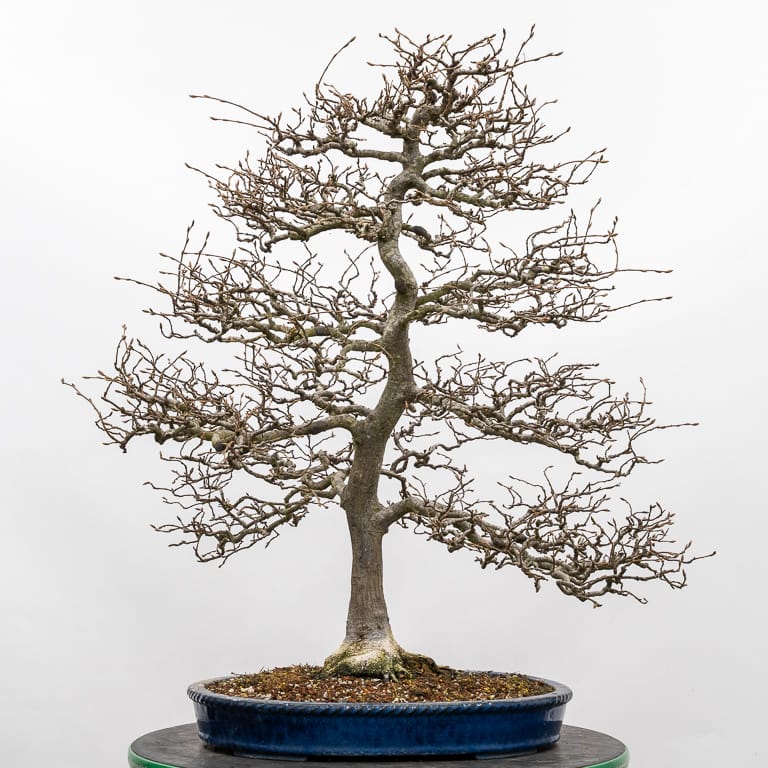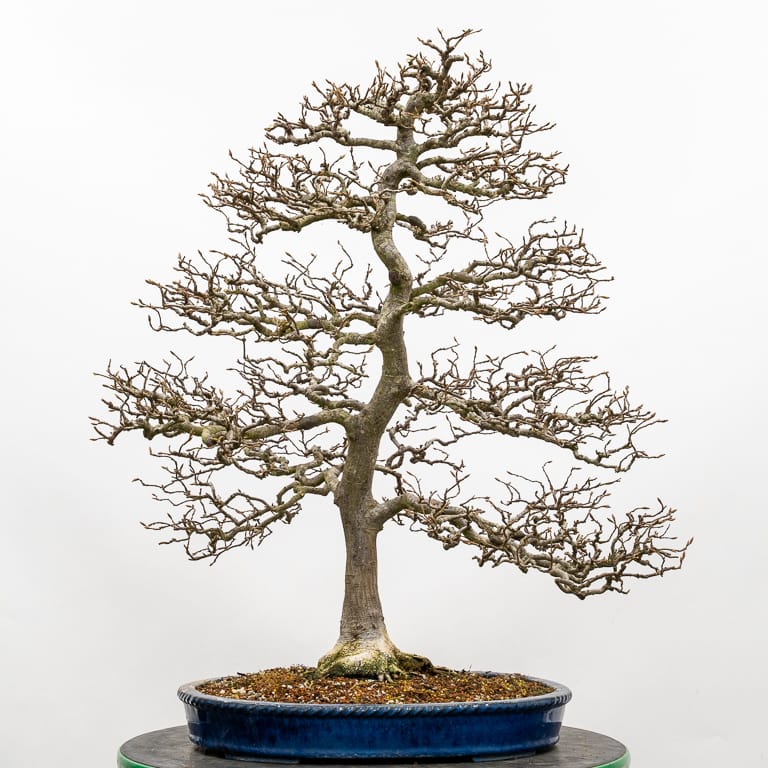When I sat down to work on the hornbeam below, I thought about how the tree was created. The branches have a contorted appearance – so much so that I wondered if this is a contorted cultivar.

Informal upright hornbeam

After removing the old leaves
If the contortions are natural, I’d like to preserve them as I develop the tree. If they were created by pruning and wiring, I’ll work with these patterns to ensure that the fine ramification has the same character as the larger branches.
The tree was developed by Gene Lynch of the Redwood Empire Bonsai Society over many years. After removing the long shoots and some of the crossing branches, the silhouette became clear.

After cutback – 29″
Going forward, I’ll be weighing options for future development. Will greater density improve the design or look “heavy” considering the slender trunk? Will a narrower silhouette with greater variation between branch length make for a more dynamic design or look out of place given the gentle movement of the trunk?
I’ll think about these and other questions during the winter months and will look forward see what becomes of the tree going forward!
Book Updates
The Little Book of Bonsai has been having a good holiday season. Last month it was named one of the best Home and Garden books of the year by Barnes & Noble (I never thought I’d appear on a list with Martha Stewart).
This month the book received a brief review on TikTok from the bonsai-themed account of Tobin Mitnik. If you need a dose of TikTok-style bonsai levity, I highly recommend checking out his channel (and the review) here.
Subscribe to Bonsai Tonight
New Posts Delivered Every Tuesday and Friday
Mark says
Slender trunk. Yup. It requires “unslendering”. The fastest way of doing that is using a sacrifice branch. I recommend one of the branches in the middle of the trunk is grown unchecked (after being wired upwards) and when it’s done it’s job, being … sacrificed. While the thickening of the trunk is going on, one should also pay some attention to further development of the nebari.
M.
Zack Clayton says
The slender trunk is a design feature. It doesn’t need thickening. The tree is elegant.
DAVID DEGROOT says
I love slender-trunked trees and the grace gentle movement imparts. If branches remain dense and the trunk thickens more, the gentle movement and grace now present might be lost. For my taste, I would further thin the branches to bring them into better balance with the trunk and accentuate the distinctive movement of individual secondary and tertiary branches. Not a right or wrong issue, of course – just my personal taste.
Congratulations on the success of your book!
Jonas Dupuich says
Thanks, Dave! I’m with you about maintaining the slender movement and feeling of the tree. I’ll see how the tree does this year and look to do more significant cutback next year to restore the balance between trunk and branches.
Thomas says
There is a very skinny but very tall red maple that I pass on my commute nearly everyday. To me it has a really great feel and an old character of its own even though it has not much girth to speak of. It has branches that even though they are short still have lots of “ramification” and character. I’ve wanted to create a tree of my own in this manner for some time.
This is how I’d see the development of this tree if it were mine I think. I also like the character of this trunk. Not every tree needs to have a massive trunk. So I would not want to try to fatten it up at all, but I would bring the branch length in a fair bit I think.
My 2 cents. That’s all. Nice tree Jonas!
Jonas Dupuich says
Thanks, Thomas! The red maple you’re describing sounds like an attractive tree (I’ll be posting about one soon). And I like your idea about bringing in the branch length – it’s on the list for next year!
Boris says
It’s a very nice example of everything in the ‘right’ place. Ichi, ni , san.. back etc The isn’t too much open space between the first back and the ni, in general the open spaces are much clearer in the right side than in the left.
The only thing that ‘bothers’ me a little is the long distance between branches around 1/2 of the tree. Until that point, the distance between branches is diminishing and then it’s fairly large.
Congrats on the book, it’s under my xmas tree
Jonas Dupuich says
Thanks, Boris! That’s a good point – there is a cluster of branches just above and below the black spot mid-way along the trunk. I think opening up some space between the other branches and developing the back branch that’s growing into the gap will help. There may also be an opportunity to reduce a branch or two in the more congested areas. It’ll be a fun tree to work with!
Omar A says
Hey Jonas,
Would love to see a post or podcast similar to your overwintering post about work to be done on trees during winter. The general gist of things seems to be deciduous pruning, minor work on conifers, but I’m sure theres more detail than that. Great post as usual, thanks!
Jonas Dupuich says
Thanks, Omar – great idea! A lot will depend on where you live, but we can typically do any work on conifers and varying amounts of work on deciduous and broadleaf evergreen species in winter as long as the trees are protected afterwards. I’m working on a way to convey the details in a way that works for different species and clients and will share it if I can figure it out. Thanks for the suggestion!